Farm Youth Died When He Became Entangled in an Unguarded PTO Shaft
Investigation: # 03MI052
SUMMARY
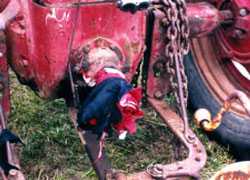 |
| Figure 1. Clothing entangled on bolt on PTO tractor stub shaft |
RECOMMENDATIONS
- All rotating shafts, including tractor stub shafts, should be covered by shields/guards in good condition when the tractor is operated.
- Tractor operators should always disengage the PTO, shut off the engine, and if applicable, remove the key before getting off of the tractor.
- Operators should not wear loose-fitting or frayed clothing that can get caught in machinery. Also, jackets and sweatshirts with draw-strings can get caught on rotating shafts
INTRODUCTION
On Friday, May 23, 2003, a 13-year-old male farm youth was killed when he became entangled in an unguarded powered take-off (PTO) shaft. MIFACE researchers were informed of the farm work-related fatality by a newspaper clipping. On September 17, 2003, MIFACE researchers interviewed the youth’s father and viewed and photographed the tractor and hay rake involved in the incident. During the course of writing this report, the medical examiner’s report, death certificate, and police department report were obtained. Figures 1-3 and Figures 5-6 are photographs taken at the scene by the responding sheriff’s department. Figure 4 and Figure 7 were taken at the time of the MIFACE farm visit.
The family dairy farm has 300 head of livestock and approximately 200 acres planted with hay. The victim was born and raised on the farm and, according to his father, was very experienced running farm equipment. His father had been a farmer for approximately 40 years. The family has a business arrangement with the property owner where the incident took place. The property owner furnishes the forage crop, and the victim’s family is responsible for harvesting. They split the profits. The victim had previously attended 4-H tractor safety classes, and according to his father, had “passed with flying colors”. The farm did not have a written health and safety plan. Both tractors used in this incident were purchased “used” and did not come equipped with the PTO master shields.
INVESTIGATION
The victim had stayed home from school on the day of the incident because of a halter that was too tight on one of his heifers. Later in the day, he and his cousin began raking the hay in a field that had been cut a few days earlier on an adjoining property. The victim was using a late 1940’s Farmall Model M tractor. (See Figure 2) His cousin was using a 1953 Model Farmall tractor. Both tractors were being operated at the time of the incident without the PTO master shield in place.
Each tractor was equipped with a non-PTO powered hay rake attached to the tractor drawbar. Both tractors had a board placed along the drawbar frame to assist in climbing on and off of the tractor. The tractor was normally mounted and dismounted by climbing on/off at the rear of the tractor instead of the side. The distance between the drawbar and the ground was approximately 18 inches. On the victim’s tractor, there was a chain wrapped around the tractor axle. The axle was approximately 21 inches from the ground. To step out from the tractor seating area to outside of the drawbar was 22 inches. (See Figure 3)
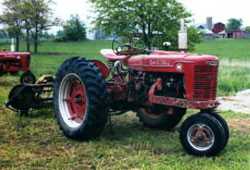 | |
Figure 2. Tractors parked at incident site | Figure 3. Board, chain and rake attachment on victim’s tractor |
The tractor the victim’s cousin was operating did not have an owner-modified extension PTO extension lever. The PTO activating lever on this tractor was located on the operator’s left at the rear of the seat. (See Figure 4) To operate the power take-off with the tractor standing still, the gearshift lever must be in neutral position. The operator must disengage the clutch and pull the power take-off shifter rod all the way up, then slowly engage the clutch. The original shifter rod required that the tractor operator turn around while in seated and pull up on the lever to activate the PTO. Note: The victim’s father mounted PTO master shield seen in Figure 4 after the incident.
The victim’s tractor had an owner-modified extension lever to activate the 540-rpm PTO (See Figure 5). The victim’s father added an aftermarket extension lever to activate the PTO because the PTO shaft was worn when the tractor was purchased. (See Figure 5) The aftermarket extension located allowed the operator to activate the PTO without turning around. The extension attached to the original lever extended to a pivot point at the top of the axle housing and then extended under the seat. This lever handle was approximately a one-half inch diameter steel rod with an aluminum pop can that was used as a handle over the end. To engage the PTO, the extension lever must be pushed forward. The PTO replacement parts were at the farm but had not yet been installed. The victim’s cousin’s tractor did not have the extension lever.
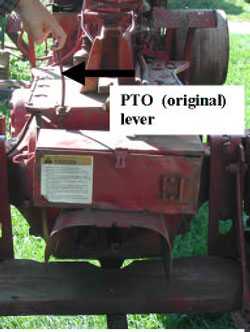 | 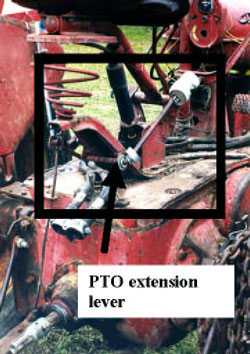 |
Figure 4. Original PTO engagement configuration | Figure 5. Owner-modified PTO extension lever |
The PTO shaft on the victim’s tractor had a six-inch extension bolted to the original shaft with a 5/16-inch bolt that protruded from the shaft by about 1-¼ inches. (See Figure 6) According to the police report, the PTO master shield had been missing for an extended period of time as evidenced by the buildup of dirt and grease around the anchoring bolts.
The victim, wearing a sweatshirt and long pants, and his cousin had been working in the field for less than one hour. The ground was fairly flat and the ground surface was dry. The victim had completed his last row and had driven the tractor to the barn to wait for his cousin to finish his row. It is unknown if the PTO was in operation while the victim was raking; there wouldn’t have been a reason for the PTO to be engaged.
 |
Figure 6. Unguarded PTO extension bolt |
An individual working on a nearby fence saw the victim get off of the tractor. The tractor was left running. It is unknown if the victim had disengaged the PTO prior to dismounting. Also unknown is how the victim dismounted from the tractor, whether he dismounted “face forward” or had climbed down facing the tractor seat. It is unknown at what point in time the victim’s sweatshirt covering the victim’s right arm became caught on the exposed bolt, while he was dismounting or remounting the tractor, or while standing on the ground. The victim’s father thought that he would have gotten off and on to the tractor from the right (passenger) side, where the chain is located. When his cousin had finished raking his row, he parked his tractor approximately 15 yards away from the victim’s stationary, idling tractor. His cousin got off of his tractor and went over his cousin’s tractor. He saw the victim lying on the ground. He turned off the tractor, and ran to the property owner’s home, notifying the owner about what happened. The individual working on the fence saw the cousin run to the house and went over to see what was wrong. He saw the victim lying on the ground and called emergency response. Emergency responders arrived and declared the victim dead at the scene.
A couple of possible incident scenarios have been developed by MIFACE. They are detailed below.
- The PTO was disengaged and the tractor was at “idle” speed. The victim dismounted the tractor by walking off facing away from the tractor rather than backing down off the tractor platform and holding on to the tractor seat or partial fender (see Figure 3) on the right side of the tractor. While dismounting, the victim slipped and while attempting to regain his balance, pushed the PTO extension lever downward, activating the PTO. While falling, the victim’s clothing was caught on the rotating shaft.
- The PTO was engaged and the tractor was at “idle” speed. The victim dismounted from the tractor by walking off facing away from the tractor rather than backing down off the tractor platform and holding on to the tractor seat or partial fender (see Figure 3) on the right side of the tractor. While dismounting, the victim slipped and his clothing was caught on the rotating shaft.
- The PTO was engaged and the tractor was at “idle” speed. The victim climbed down from the tractor while facing the tractor seat. After reaching the ground, he turned to look for his cousin. This would now place his right arm near the rotating PTO shaft.
CAUSE OF DEATH
The cause of death as stated on the death certificate was multiple blunt trauma to the lower face, neck, and right shoulder. The results of all toxicological tests were negative.
RECOMMENDATIONS/DISCUSSION
- All rotating shafts, including tractor stub shafts should be covered by shields/guards in good condition when the tractor is operated.
After the incident, the victim’s father was able to obtain two master shields by attending antique tractor shows. He had been previously unable to obtain the master shields at his local tractor supply store. Properly designed guards and/or shields should cover any rotating shafts that an individual may be exposed to.
Exposed rotating shafts are hazardous situations that can cause serious injury, and in this tragic incident, death. The International Harvester owner’s manual for the Farmall M and MV series tractors states that the engine speed, governed, at maximum full load is 1450 rpm. The power take-off shaft speed is listed at 537 rpm. A PTO operating at 540 rpm rotates around nine times/second. It takes only about one second to completely strip off an article of clothing, or if the cloth does not tear away, to wrap a body or body part around a shaft. Clothing is pulled around the shaft much quicker than a person can pull back or take evasive action. Even a quick reaction time, ½ of a second, would permit a piece of clothing to wrap around a shaft rotating at 540 rpm at least two times. In this incident, the tractor was at “idle” speed. The engine low “idles” at 425 rpm according to the International Harvester shop manual No. IH-8. The PTO shaft would be rotating at approximately 157 rpm, causing the shaft to rotate around approximately two times/second. At this rpm and rotational speed, the protruding bolt on the stub shaft could still catch a person’s clothing and begin to wrap the clothing around the shaft before the person can react.
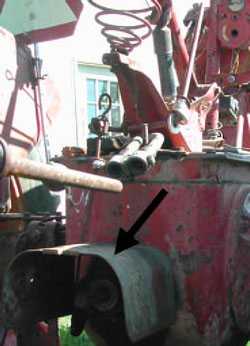 |
Figure 7. PTO Master shield in place after incident |
A total shielding system for a PTO driveline includes a tractor stub master shield, the PTO driveline shield and an implement shield. The master shield prevents the operator from accidentally coming into contact with the tractor stub shaft. This tractor was normally mounted and dismounted from the rear. When a PTO master shield is used as a step for the operator to mount or dismount the tractor, it must have sufficient strength to prevent it from being permanently deformed when stepped on by a 250-pound operator. (MIOSHA Agricultural Health and Safety Standards, Part 53, Farm Field Equipment (29 CFR 1928.57)).
MIFACE also recommends that a PTO stub shaft guard be used to completely enclose the tractor stub shaft when the PTO is not being used. The stub shaft guard will not only protect the operator but also keep the PTO stub shaft clean and in good condition. PTO shaft extensions cannot be adequately guarded with an original equipment or tractor manufacturer’s PTO master shield.
- Tractor operators should always disengage the PTO, shut off the engine, and if applicable, remove the key before getting off of the tractor.
Disengaging the PTO, turning off the tractor and removing the tractor key prior to getting off of the tractor virtually eliminates the potential for injury or death due to entanglement. Following these steps protect the operator from PTO shaft entanglements, entanglement in other moving machine parts and from unexpected engagement of power by another person while the tractor operator may be cleaning, lubricating, adjusting or repairing a machine. This fatality would have been prevented if the youth had turned off the tractor prior to getting off of the tractor. A safety “good rule of thumb” is to stay at least your height away from a rotating driveline.
- Operators should not wear loose-fitting or frayed clothing that can get caught in machinery. Also, jackets and sweatshirts with draw-strings can get caught on rotating shafts.
The risk of entanglement in rotating shafts and machine components can be reduced if operators do not wear loose fitting clothing. Work clothing should be well-fitting and zippered or buttoned, not open. Frayed or loose fitting clothes, jackets and sweatshirts with drawstrings, and boots or shoes with long shoelaces should be avoided. Long hair should be tied back or under a cap.
REFERENCES
- MIOSHA Agricultural Health and Safety Standards, Part 53, Farm Field Equipment (29 CFR 1958.57)
- National Safety Council Fact Sheet Library, PTO Safety, Internet Resource: http://www.nsc.org/news_resources/Resources/Pages/SafetyHealthFactSheets.aspx (Link updated 11/12/2009)
- Power Take-Off (PTO) Safety, Fact Sheet Safety-33, Dennis J. Murphy, Agricultural Engineering Department, Cooperative Extension Service, Pennsylvania State University, University Park, PA 16802. Internet Resource: NASD (National Ag Safety Database) www.nasdonline.org/index.html (Link updated 8/5/2009)
- Shield Yourself From PTO Dangers, Howard J. Doss, Agricultural Safety Specialist, Michigan State University Extension, East Lansing, MI 48824. Internet Resource: NASD (National Ag Safety Database), http://www.nasdonline.org/index.html (Link updated 8/5/2009)
- International Harvester Shop Manual for Super and Non-super series tractors, Manual No. IH-8, Implement & Tractor Publications, Inc. Kansas City, MO.
- Owners Manual, Special Attachments, Farmall H,H, MD series tractor. International Harvester Company, 180 North Michigan Ave., Chicago, IL, 1942
- Owners Manual, Farmall M and MV, International Harvester Company, 180 Michigan Ave., Chicago, IL, 1949
MIFACE (Michigan Fatality and Control Evaluation), Michigan State University (MSU) Occupational & Environmental Medicine, 117 West Fee Hall, East Lansing, Michigan 48824-1315. This information is for educational purposes only. This MIFACE report becomes public property upon publication and may be printed verbatim with credit to MSU. Reprinting cannot be used to endorse or advertise a commercial product or company. All rights reserved. MSU is an affirmative-action, equal opportunity employer. 2/23/04
To contact Michigan State FACE program personnel regarding State-based FACE reports, please use information listed on the Contact Sheet on the NIOSH FACE web site Please contact In-house FACE program personnel regarding In-house FACE reports and to gain assistance when State-FACE program personnel cannot be reached.
MIFACE
Investigation Report # 03 MI 052
Evaluation
| To improve the quality of the MIFACE program and our investigation reports, we would like to ask you a few questions regarding this report. | |||
| Please rate the following on a scale of: | |||
| Excellent | Good | Fair | Poor |
| 1 | 2 | 3 | 4 |
| What was your general impression of this MIFACE investigation report? | |||
| Excellent | Good | Fair | Poor |
| 1 | 2 | 3 | 4 |
| Was the report… | Excellent | Good | Fair | Poor |
| Objective? | 1 | 2 | 3 | 4 |
| Clearly written? | 1 | 2 | 3 | 4 |
| Useful? | 1 | 2 | 3 | 4 |
| Were the recommendations … | Excellent | Good | Fair | Poor |
| Clearly written? | 1 | 2 | 3 | 4 |
| Practical? | 1 | 2 | 3 | 4 |
| Useful? | 1 | 2 | 3 | 4 |
| How will you use this report? (Check all that apply) | |
| O | Distribute to family members/employees |
| O | Post on bulletin board |
| O | Use in employee training |
| O | File for future reference |
| O | Will not use it |
| O | Other (specify) __________________________________________ |
Thank You!
Please Return To:
MIFACE
Michigan State University
117 West Fee Hall
East Lansing, MI 48824
FAX: 517-432-3606
Comments:
| If you would like to receive e-mail notifications of future MIFACE work-related fatality investigation report summaries, please complete the information below. | |
| Name: __________________________________________ | |
| e-mail address: ___________________________________ | |
| I would like to receive summaries for reports involving: | |
| ___ Construction | ___ Agriculture |
| ___ Manufacturing | ___ All |
Back to NIOSH FACE Web
- Page last reviewed: November 18, 2015
- Page last updated: October 15, 2014
- Content source:
- National Institute for Occupational Safety and Health Division of Safety Research


 ShareCompartir
ShareCompartir